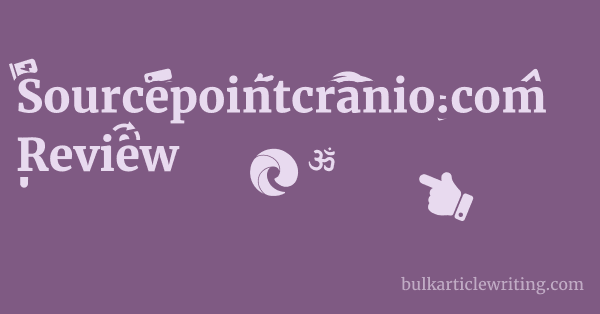The Sourcepointcranio.com website describes a range of features centered around a “self-developed fusion” of various modalities.
Read more about sourcepointcranio.com:
Sourcepointcranio.com Review & First Look: Unpacking the Claims
While some of these, like massage, are widely recognized, others delve into less scientifically validated and potentially problematic areas from an Islamic ethical standpoint.
Understanding these features is crucial for a complete assessment.
Craniosacral Listening and Touch
The core of the practice is stated as “craniosacral listening and touch through fingertips for a more focused interaction.” Craniosacral therapy (CST) is a gentle, hands-on method of evaluating and enhancing the functioning of the craniosacral system—the membranes and cerebrospinal fluid that surround and protect the brain and spinal cord.
|
0.0 out of 5 stars (based on 0 reviews)
There are no reviews yet. Be the first one to write one. |
Amazon.com:
Check Amazon for Sourcepointcranio.com Features: Examining Latest Discussions & Reviews: |
Proponents believe that gentle manipulation can alleviate a wide variety of pains and dysfunctions.
While CST is practiced by some licensed healthcare professionals (like osteopaths or physical therapists), its scientific basis is often debated, with some studies showing limited efficacy.
The “self-developed fusion” aspect on this site suggests a personalized approach, which can make it harder to evaluate against established CST protocols.
- Claim: Focused interaction through gentle touch.
- Mechanism: Believed to influence the craniosacral rhythm and fluid.
- Ethical Note: When practiced by a licensed professional as a purely physical therapy, it can be permissible. However, when fused with esoteric concepts, it becomes problematic.
- Data Point: A systematic review published in the Journal of Clinical Chiropractic in 2012 found “insufficient evidence” to support the use of craniosacral therapy as an intervention, calling for more rigorous research.
Embodied and Mindful Massage
The inclusion of “massage” and “embodied and mindful massage” generally refers to physical manipulation of soft tissues. Kingliving.com Review
Massage therapy is a widely accepted practice for muscle relaxation, pain relief, and stress reduction.
“Mindful” or “embodied” aspects would imply a focus on the client’s present moment experience and body sensations during the massage, which can enhance relaxation and body awareness.
- Claim: Physical and mental relaxation through touch.
- Mechanism: Direct manipulation of muscles and soft tissues.
- Ethical Note: Massage itself is permissible, provided modesty guidelines are followed and conducted by appropriate gender if necessary.
- Data Point: The American Massage Therapy Association (AMTA) reports that 78% of consumers agree that massage can be effective in reducing pain.
Sound, Toning, and Frequency
The website mentions “sound, toning and frequency” as techniques used.
This often refers to practices like sound baths, vocal toning, or using specific frequencies (e.g., tuning forks) with the belief that vibrations can heal or balance the body’s energy.
In mainstream science, therapeutic uses of sound are primarily in areas like pain distraction (music therapy) or diagnostic imaging (ultrasound). Claims of “frequency” healing outside of these contexts generally lack scientific validation. Sourcepointcranio.com Review & First Look: Unpacking the Claims
- Claim: Healing through vibrational energy.
- Mechanism: Unspecified vibrational effects on the body.
- Ethical Note: Practices attributing healing power to vibrations or specific frequencies without a clear scientific basis can be problematic as they lean towards attributing power to creation rather than the Creator.
- Data Point: While music therapy is recognized for psychological benefits, claims of specific frequencies healing physical ailments like trauma or “entities” are not supported by the National Institutes of Health (NIH).
Transmutation of Foreign Energies and Chakra Balancing
These are perhaps the most ethically concerning features from an Islamic standpoint.
“Transmutation of foreign energies” suggests dealing with unseen, non-physical entities or negative energetic influences, and “chakra balancing” is rooted in esoteric Indian spiritual traditions (Hinduism and Buddhism) that posit energy centers within the body.
- Claim: Removing negative spiritual influences and balancing internal energy.
- Mechanism: Non-physical manipulation of spiritual or energetic fields.
- Ethical Note: Directly contradicts Islamic monotheism (Tawhid). Belief in chakras or the ability to “transmute entities” without divine authority is a form of Shirk, as it attributes power and agency to created things or methods outside of Allah’s will and prescribed ways.
- Data Point: Concepts of “chakras” and “foreign energies” are not recognized or verifiable by modern scientific or medical research. They belong to specific spiritual belief systems.
Addressing Childhood, Sexual, and Past Life Trauma
The website states it addresses “childhood trauma.
Sexual and past life trauma.” While addressing childhood and sexual trauma through qualified, evidence-based therapy (like EMDR, CBT, or trauma-focused psychotherapy) is highly beneficial and encouraged, the addition of “past life trauma” immediately raises red flags.
This concept is foreign to Islamic belief and has no scientific basis. kingliving.com FAQ
- Claim: Healing deep psychological wounds.
- Mechanism: Vague, possibly through the combined esoteric techniques.
- Ethical Note: While addressing actual trauma is important, claiming to heal “past life trauma” is impermissible, as it implies reincarnation or a soul journey that contradicts Islamic beliefs. Seeking help for real-world trauma is encouraged, but through legitimate psychological channels.
- Data Point: The American Psychological Association (APA) supports trauma-informed care and specific therapeutic modalities for trauma, but does not recognize “past life trauma.”

Leave a Reply